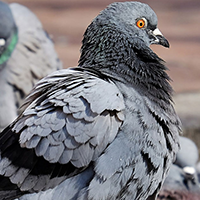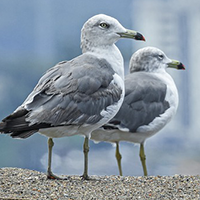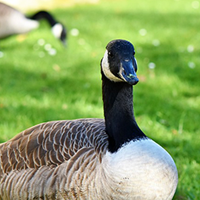Falconry-based bird control is a sophisticated and environmentally responsible method of managing nuisance bird populations. In Canada, this process is mainly used for gulls and pigeons. It leverages the natural hunting instincts and behaviours of birds of prey to deter, scare, or sometimes remove smaller birds that pose economic or health-related issues in various settings. This form of bird control is increasingly preferred over more traditional methods, such as the use of poisons, nets, or noise-making devices, which can be less effective, more intrusive, and potentially harmful to the environment and non-target species. Here are some main points to help you understand the history, process, application, and benefits of falconry-based bird control. We will also dive into the main locations that falconry-based bird control is commonly used.
1. Historical Context and Evolution
Falconry, the practice of training raptors to hunt, dates back millennia and is a tradition that has been passed down through generations and across many different cultures. The adaptation of falconry for the purpose of bird control is a relatively recent development. As society evolves and many areas once populated by forest become increasingly more inhabited by businesses and homes, the need for more humane and ecological methods of managing wildlife populations has become a necessity. Falconry, once used only for sport, has become a practical and effective solutions for many.
2. Training and Falconer Expertise
The success of falconry-based bird control hinges heavily on the expertise of the falconer and the training of the birds. Falconers must have a deep understanding of raptor behaviour, bird ecology, and the specific dynamics of the nuisance species they are trying to control. Birds of prey are trained through a process that involves trust-building, learning commands, and conditioning the birds to work in various environments. Falcons, hawks, and sometimes even eagles are taught to work in cooperation with a falconer to fly over problem areas and sometimes predate on nuisance bird species using a technique called ‘kill-to-scare’; although not always necessary. Knowing which falconry bird species would be most effective for your bird control problem is the key to success in this arena. For example, birds that typically predate on ground animals may not be as effective in scaring away or predating on nuisance birds. These factors are up to the falconer to decide in order to provide the best service possible.
3. Raptors in Bird Control
Different species of raptors (birds of prey) are chosen based on their suitability to the environment and the target pest species.
Falcons (e.g. Peregrine Falcons, Gyrfalcons)
Known for their incredible speed and agility, they are often used in open areas or in settings where their high-speed hunting flights can deter other birds. Peregrine Falcons will typically capture their prey mid-air. The prey of the peregrine falcon solely consists of bird species, although the size can range from small song birds all the way to large geese and other shore birds. The Gyrfalcon varies slightly in the sense that they will typically knock prey down while flying and then gather them on the ground. In addition a Gyrfalcon will also predate on ground mammals such as hare.
Hawks (e.g. Harris's Hawks, Red-tailed Hawks)
Known for their ability to navigate through more enclosed spaces, they are ideal for hunting in urban environments or agricultural settings. These birds are known for perching and gliding down to capture prey with their talons. With very similar diets, these hawks typically predate on rabbits, rodents, and other birds; even up to the size of a pheasant. Red-tailed Hawks and Harris’s Hawks do differ somewhat in their hunting ability. For example, Red-tailed Hawk’s are more keen at capturing say a squirrel in a tree. These slight differences in hunting ability can make all the difference when choosing what bird of prey will be used for each particular situation.
Eagles (eg.Golden Eagle, Bald Eagle)
Although less commonly used due to their size and the nature of their hunting, Eagles can be effective in certain situations where larger birds need to be controlled. In the wild, Bald Eagles will typically predate on fish, but they also hunt for ducks, geese and small mammals. Whereas the Golden eagles will hunt a far larger variety of mammals ranging in size from a ground squirrel to a deer, coyote, or bobcat. Both raptors can provide excellent services in terms of bird control as just their sheer presence will inflict fear upon any nuisance bird.
4. Common Problem Areas
Falconry bird control can be applied in numerous settings, each presenting unique challenges:
Airports
The presence of birds, especially flocking species like geese, can be a significant hazard for aircraft. A wide variety of falconry birds are used at almost every airport to prevent any danger of bird strikes with aircrafts. Using falconry here can save lives by reducing the risk of bird strikes. It is reported by Bird Strike Canada that nearly 2000 bird strikes with air crafts occur each year. Using falconry at all airports will drastically help to reduce this number and making flying safer for birds and passengers.
Agriculture
Crop damage and food consumption by birds can cause significant economic losses for farmers. If gone unchecked, birds could destroy an entire seasons crop. Falconry is an excellent and humane technique for protecting agriculture. Raptors patrol the skies above fields and orchards to scare off species that might otherwise feed on the produce.
Urban Areas
Pigeons, gulls, and other birds can create unsanitary conditions and damage structures with their droppings. Industrial roof tops are a main concern in this aspect. HVAC systems on roofs can become contaminated with feces and nesting material leading to poor air quality in these building. Ultimately this posses significant health concerns. Falconry can help maintain a bird-free environment around buildings, parks, and other public spaces.
Waste Management
Gulls and other birds that feed on refuse can spread litter, create noise pollution, and can become a huge inconvenience. Falconry is one of the many techniques used to help keep bird populations to a minimum at landfills and waste processing facilities.
Aquaculture
Fish farms can attract predatory birds like cormorants. These birds will predate on the fish causing a depletion in fish stocks. Raptors can be used to patrol these areas, create fear in the pest birds to assist in protecting the fish stocks.
Pros of Falconry-based Bird Control
- Natural Deterrence
Birds of prey are natural predators for many smaller bird species, creating a natural deterrent without causing harm to the nuisance birds.
- Non-lethal Method
Falconry-based bird control is a humane and non-lethal method. The goal is to scare off or intimidate nuisance birds rather than causing harm.
- Environmentally Friendly
Unlike some chemical or mechanical bird control methods, falconry-based bird control does not introduce harmful substances into the environment.
- Selective Targeting
Falconers can train their birds to focus on specific bird species, providing a targeted approach to bird control without affecting non-targeted species.
- Adaptability
Falconry-based bird control is adaptable to various environments, including agricultural areas, airports, and urban spaces. Birds of prey can be trained to address specific bird-related issues in different settings.
- Reduced Health Risks
Nuisance birds can pose health risks, especially in areas where they congregate in large numbers. Falconry-based bird control helps minimize the spread of diseases associated with bird droppings without resorting to harmful chemicals.
- Long Term Cost-Effectiveness
While the initial investment in falconry training and equipment may be significant, the long-term costs can be lower than some other bird control methods that require ongoing maintenance or the use of chemicals.
- Public Relations & Aesthetics
Falconry-based bird control is often perceived positively by the public, as it is seen as a natural and ethical way to address bird-related issues. Additionally, the presence of trained birds of prey can be aesthetically pleasing and adds a unique aspect to certain environments.
- Educational Opportunities
Falconry provides educational opportunities for the public, as people can learn about the natural behaviours of birds of prey and the importance of maintaining a balance in ecosystems.
- Customization
Falconry-based bird control programs can be customized to suit specific needs and challenges in different locations. Falconers work closely with clients to develop strategies that address particular bird-related issues. While falconry-based bird control offers various benefits, it is essential to note that successful implementation requires skilled and experienced falconers who understand both the behaviour of birds of prey and the specific challenges posed by nuisance birds in a given environment.
Related Articles: Why does Falconry work for Bird Control?
















